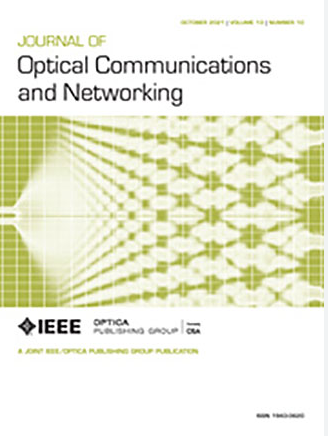多波段光学系统传输质量优化:一种逐步多设备联合配置算法
IF 4.3
2区 计算机科学
Q1 COMPUTER SCIENCE, HARDWARE & ARCHITECTURE
引用次数: 0
摘要
由于可配置器件数量的增加和光纤非线性效应(如受激拉曼散射效应)的放大影响,超宽带传输系统的性能优化变得越来越复杂。为了解决这些问题并推动多波段传输系统的全面优化,我们提出了一种逐步算法来联合配置多个设备,从而提高${\rm S} + {\rm C} + {\rm L}$波段传输系统的性能。这种逐步配置方法通过考虑各种线性和非线性效应来加速最佳配置的识别,同时结合对在线放大器以外的多个器件的调整。这种灵活性允许在不同条件下进行量身定制的优化,以更低的成本实现更高的性能。对八跨${\rm C} + {\rm L} + {\rm S}$频段链路的仿真研究表明,与传统方法相比,仅使用该算法优化放大器的广义信噪比(GSNR)提高了2.2 dB,同时优化时间缩短了一半。进一步配置波长选择开关(wss)可以提高GSNR的平坦度,即使在放大器增益谱不均匀的情况下,也可以将每个频段的最大和最小GSNR值之间的差异降低到0.2 dB以下。此外,在多个相邻信道中同时配置WSS的有效方法将优化时间减少了大约十倍。本文章由计算机程序翻译,如有差异,请以英文原文为准。
Quality of transmission optimization in a multi-band optical system: a stepwise multi-device joint configuration algorithm
Performance optimization in ultra-wideband transmission systems becomes increasingly complex due to the higher number of configurable components and the amplified impact of fiber nonlinearities, such as the stimulated Raman scattering effect. To address these challenges and advance multi-band transmission systems toward comprehensive optimization, we propose a stepwise algorithm to jointly configure multiple devices, enhancing the performance of ${\rm S} + {\rm C} + {\rm L}$ -band transmission systems. This stepwise configuration approach accelerates the identification of optimal configurations by considering various linear and nonlinear effects while incorporating adjustments to multiple devices beyond in-line amplifiers. This flexibility allows for tailored optimizations under varying conditions, achieving improved performance at a reduced cost. A simulation study of an eight-span ${\rm C} + {\rm L} + {\rm S}$ -band link demonstrates that optimizing amplifiers alone using the proposed algorithm achieves a comparable 2.2 dB improvement in generalized signal-to-noise ratio (GSNR) while reducing the optimization time by half compared to traditional methods. Further configuring wavelength-selective switches (WSSs) improves GSNR flatness—reducing the difference between maximum and minimum GSNR values to below 0.2 dB in each band, even under uneven amplifier gain spectra. Additionally, an efficient method for simultaneously configuring WSS in multiple adjacent channels reduces optimization time by approximately tenfold.
求助全文
通过发布文献求助,成功后即可免费获取论文全文。
去求助
来源期刊
CiteScore
9.40
自引率
16.00%
发文量
104
审稿时长
4 months
期刊介绍:
The scope of the Journal includes advances in the state-of-the-art of optical networking science, technology, and engineering. Both theoretical contributions (including new techniques, concepts, analyses, and economic studies) and practical contributions (including optical networking experiments, prototypes, and new applications) are encouraged. Subareas of interest include the architecture and design of optical networks, optical network survivability and security, software-defined optical networking, elastic optical networks, data and control plane advances, network management related innovation, and optical access networks. Enabling technologies and their applications are suitable topics only if the results are shown to directly impact optical networking beyond simple point-to-point networks.

 求助内容:
求助内容: 应助结果提醒方式:
应助结果提醒方式:


